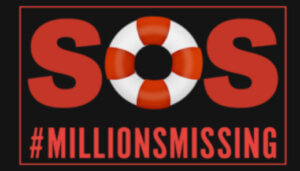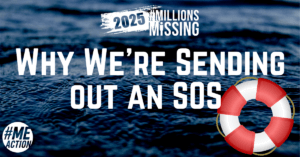 Values and Policies Process Announcement
Values and Policies Process Announcement
A few months ago, #MEAction Executive Director Jennifer Brea released an open letter, outlining the importance of forming #MEAction’s values and policies as a community.
#MEAction’s community-based model utilizes the strengths of our staff team to support, organize and amplify the voices of thousands of volunteers, activists, people with ME, and allies around the world. As such, we’ve always been a big tent: many of our volunteers and activists hold differing viewpoints re: what tactics we should use, what policy outcomes we should fight for, and what values should guide us.
#MEAction has grown so much over the past three years, having ever greater impact. Now is the time to come together, discuss, debate and make explicit our values and policies so that the hundreds of volunteers and activists of #MEAction can all work even better together.
Clarifying #MEAction’s values and policies is critical for the outward-facing work: engaging our elected officials, educating medical professionals, and communicating with the media. It’s also critical for building a movement that is inclusive and representative of our community’s diverse needs, perspectives, and experiences.
Read the full process outlined for you below, or help us kick off this process by taking our first poll now. We’ve extended the deadline to complete the poll until Monday, Dec. 10 at midnight.
[maxbutton id=”21″ url=”https://docs.google.com/forms/d/1CxeeEwQtmWKLNrnLHJidSlTOvQK4VDShYlF95f9hzcM/edit” text=”TAKE THE POLL” ]
The Goal:
Our goal is to add clarity to all areas of our work and for the entire community to understand #MEAction’s values and principles. We will draft a set of foundational principles, defined by #MEAction staff, volunteers, and everyone in the community, on which we will base our work. In addition, we will draft a platform of policy positions. We will share our values globally. Our policy positions may vary from country to country, depending on national context.
The Timeline:
We will begin by asking you about what issues are most important to take a stand on — and what things we should leave open in order to allow a diversity of perspectives. What do you think are the crucial principles and values for our movement? What tactics and ways of operating are important to our community? What positions does this movement need to take?
- Framing the process: Our first step is this survey to help frame the process and the topics you feel should be put on the agenda for community discussion. To begin, fill out this open form now.
- Community discussion: Over the next several months, we will solicit and release op-eds written by a variety of voices on topics you want to explore. In the comments, on forums, and social media, we’ll discuss these topics and host a series of Bluejeans conversations.
- Poll: In March of 2019, we will then poll the community on key questions emerging from these discussions.
- Adoption: In April, we’ll publish the results of these polls alongside a final document, drafted by staff and in consultation with our most engaged volunteers. That document will then be voted on by the entire community.
Who can participate?
Everyone in our community can participate! Are you in an #MEAction group? Do you follow our email list or social media? However you are involved, big or small, you are a part of our community of people with ME, caregivers, and allies.
Why this matters
As we continue to respond urgently to calls to action, the more united and clear we can be as a community, the stronger we can be. This is so important because we will continue our fight for ME health equality on more fronts, in more places.
Change can only come with your help and support. Help guide ME research, clinical care, and government action — and fight alongside us for a better future for all people with ME.
[maxbutton id=”21″ url=”https://docs.google.com/forms/d/1CxeeEwQtmWKLNrnLHJidSlTOvQK4VDShYlF95f9hzcM/edit” text=”TAKE THE POLL” ]





2 thoughts on “Values and Policies Process Announcement”
Here is a cheat sheet to help understand the different criteria.
https://www.facebook.com/notes/north-carolina-ohio-mefm-support-group/comparing-me-seid-cfs/1894462840621604/
From the Cheat Sheet:
MYALGIC ENCEPHALOMYELITIS
ME – expert criteria (most recent): International Consensus Criteria (ICC)
Link: https://onlinelibrary.wiley.com/doi/full/10.1111/j.1365-2796.2011.02428.x
ME Medical Education Materials: International Consensus Primer
Link: http://www.investinme.org/Documents/Guidelines/Myalgic%20Encephalomyelitis%20International%20Consensus%20Primer%20-2012-11-26.pdf
Note: Most materials in this group based on this primer.
US Proposed ICD Code for ME – G93.32
US Proposed ICD Section – Related Fatigue Syndromes
(objections raised by MEICC advocates)
Link to information about US proposed ICD code changes: https://www.meadvocacy.org/seid_classification_usurping_me_must_be_stopped
(Deadline to comment is Nov 13, 2018)
SYSTEMIC EXERTION INTOLERANCE DISEASE
SEID (ME/CFS) – CDC official criteria: NAM (aka IOM) report
Link: https://www.nap.edu/resource/19012/MECFScliniciansguide.pdf
SEID Medical Education Materials:
CDC Materials: https://www.cdc.gov/me-cfs/treatment/index.html
MEAction/Unrest Continuing Education Materials: https://meaction.net/unrest-ce/
US Proposed ICD Code for SEID – G93.30
US Proposed ICD Section – Related Fatigue Syndromes
COMPARISON BETWEEN ICC & IOM
https://d3n8a8pro7vhmx.cloudfront.net/meadvocacy/pages/22/attachments/original/1531592663/ICC_compared_to_IOM.pdf?1531592663
CHRONIC FATIGUE SYNDROME
CFS – CDC official criteria: Fukuda
Link to description: https://www.meadvocacy.org/analysis_of_cfsac_august_2015_recommendations_for_the_iom_criteria
US Proposed ICD Code for CFS – G93.33
US Proposed ICD Section – Related Fatigue Syndromes
WHAT YOU CAN DO
Sign the petition requesting the US government adopt ICC.
Note: As this issue affects the whole world… anyone in the world can sign.
https://www.change.org/p/the-us-department-of-health-and-human-services-cdc-adopt-the-distinct-disease-myalgic-encephalomyelitis-me-as-defined-by-icc-now
ME-ACTION
Comments are closed.